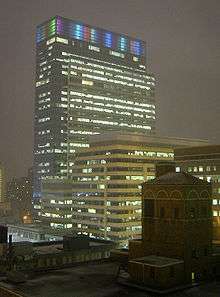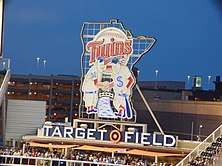Target Corporation
Target Corporation is an American retail corporation. It is the 8th-largest retailer in the United States, and is a component of the S&P 500 Index.[4] It is unrelated to Target Australia.
.svg.png) | |
Target Corporation headquarters, Target Plaza, in Minneapolis | |
Formerly |
|
|---|---|
Type | Public |
| Traded as | |
| ISIN | US87612E1064 |
| Industry | Retail |
| Founded | June 24, 1902 (corporation) January 5, 1962 (store) |
| Founders | George Dayton (corporation) John Geisse (store) |
| Headquarters | Target Plaza, 1000 Nicollet Mall Minneapolis, Minnesota, United States |
Number of locations |
|
Area served | United States |
Key people | |
| Products | Beauty and health products; bedding; clothing and accessories; electronics; food; furniture; jewelry; lawn and garden; pet supplies; shoes; small appliances; toys/games. |
| Revenue |
|
| |
| |
| Total assets |
|
| Total equity |
|
Number of employees |
|
| Subsidiaries | Target Brands, Inc. Target Capital Corporation Target Enterprise, Inc. Target General Merchandise, Inc. Shipt |
| Website | |
| Footnotes / references [2][3] | |
Target established itself as the day time division of the Dayton-Hudson Corporation in the 1970s; it began expanding the store nationwide in the 1980s and introduced new store formats under the Target brand in the 1990s. The company has found success as a cheap-chic player in the industry.[5] The parent company was renamed the Target Corporation in 2000 and divested itself of its last department store chains in 2004. It suffered from a massive and highly publicized security breach of customer credit card data and the failure of its short-lived Target Canada subsidiary in the early 2010s but experienced revitalized success with its expansion in urban markets within the United States. As of February 2nd, 2019, Target operates 1,844[2] stores throughout the United States. The company is ranked No. 39 on 2018 Fortune 500 list of the largest United States corporations by total revenue.[6] Their retail formats include the discount store Target, the hypermarket SuperTarget, and "small-format" stores previously named CityTarget and TargetExpress before being consolidated under the Target branding. Target is often recognized for its emphasis on "the needs of its younger, image-conscious shoppers", whereas its rival Walmart more heavily relies on its strategy of "always low prices".[7]
History
Finances
| Year | Revenue in mil. USD$ |
Net Income in mil. USD$ |
Total Assets in mil. USD$ |
Employees | Stores |
|---|---|---|---|---|---|
| 2005 | 46,839 | 3,918 | 32,293 | 292,000 | 1,308 |
| 2006 | 52,620 | 2,408 | 34,995 | 338,000 | 1,397 |
| 2007 | 59,490 | 2,787 | 37,349 | 352,000 | 1,488 |
| 2008 | 63,637 | 2,849 | 44,560 | 366,000 | 1,591 |
| 2009 | 64,948 | 2,214 | 44,106 | 351,000 | 1,682 |
| 2010 | 65,357 | 2,488 | 44,533 | 351,000 | 1,740 |
| 2011 | 67,390 | 2,920 | 43,705 | 355,000 | 1,750 |
| 2012 | 69,865 | 2,929 | 46,630 | 365,000 | 1,763 |
| 2013 | 73,301 | 2,999 | 48,163 | 361,000 | 1,778 |
| 2014 | 71,279 | 1,971 | 44,553 | 366,000 | 1,917 |
| 2015 | 72,618 | 1,636 | 41,172 | 347,000 | 1,790 |
| 2016 | 73,785 | 3,363 | 40,262 | 341,000 | 1,792 |
| 2017 | 69,495 | 2,737 | 37,431 | 323,000 | 1,802 |
| 2018 | 71,879 | 2,934 | 38,999 | 345,000 | 1,822 |
| 2019 | 75,356 | 2,937 | 41,290 | 360,000 | 1,851 |
Store formats
Target
.jpg)
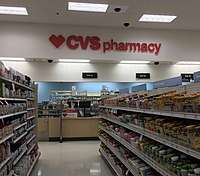
The first Target discount store opened in Roseville, Minnesota on May 1, 1962.[9] Present-day properties are roughly 135,000 square feet (12,500 m2) and sell general merchandise including hardlines and softlines.[10] While many Target stores follow a standard big-box architectural style,[11] the company has focused on "customizing each new store to ensure a locally-relevant experience [...] that best fit the surrounding neighborhood’s needs" since August 2006.[12] Initially, only SuperTarget locations operated Starbucks Coffee counters, although they were integrated into general merchandise stores through their expanded partnership beginning in 2003.[13]
Target introduced the "PFresh" store prototype in 2006, which expanded its grocery selection in general merchandise locations by an upwards of 200-percent. Newly constructed stores that follow the PFresh format are roughly 1,500 square feet (140 m2) larger than properties without groceries, although retain the Target branding because their offerings are considerably more limited than SuperTarget. The company remodeled 109 stores accordingly in 2006 and renovated another 350 stores the following year.[14] The company's decision to close their garden centers opened floor space for PFresh expansion and larger seasonal departments beginning in 2010.[15]
On June 15, 2015 CVS Health announced an agreement with Target to acquire all of Target's pharmacies and clinic businesses for around $1.9 billion. The Target pharmacies were rebranded as CVS Health pharmacies which totaled 1,672 pharmacies. The Target clinics were also rebranded as MinuteClinic. The acquisition of the Target pharmacies enabled CVS to expand its market into Seattle, Denver, Portland, and Salt Lake City. The Target pharmacies were rebranded to CVS Health pharmacies in February 2016.[16][17]
SuperTarget
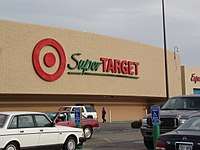
The first Target Greatland location opened in Apple Valley, Minnesota in September 1990. They were about fifty-percent larger than traditional Target stores, and pioneered company standards including an increased number of checkout lanes and price scanners, larger aisles, expanded pharmacy and photography departments, and a food court. Target Greatland locations have since been converted to stores following the PFresh format beginning in 2009.[18]
The first Super Target hypermarket opened in Omaha, Nebraska in 1995, and expanded upon the Target Greatland concept with the inclusion of a full grocery department.[9] The company expanded their grocery assortment in 2003 and adopted the modified tagline "Eat Well. Pay Less." (in reference to their tagline "Expect More. Pay Less.") in 2004.[9][19] In the early 2000s, 43 locations (of nearly 100) featured E-Trade trading stations, although they were all closed by June 2003 after E-Trade determined that "we were not able to make it into a profitable distribution channel."[20]
When comparing itself with rival Walmart Supercenter hypermarkets, then-chief executive Gregg Steinhafel opined that Walmart operates like "a grocer that happens to also sell general merchandise," where in contrast its less aggressive expansion of SuperTarget stores is indicative of their position that the grocery industry as a "high-impact, low-cost" side project.[19] The company operated 239 SuperTarget locations as of September 2015;[21] they each encompass an estimate of 174,000 square feet (16,200 m2).[22]
In August 2015, Target made the announcement of "Big or small, our stores have one thing in common: they're all Target."[23] Since then newer stores have opened under the Target name. Existing SuperTarget stores retained the name on the buildings although some have become Target through remodels.
Small-format Target
.jpg)
While typical Target locations are approximately 135,000 square feet (12,500 m2), the majority of "small-format" CityTarget stores are roughly 80,000 square feet (7,400 m2). The first stores were opened in July 2012, in Chicago, Los Angeles, and Seattle;[10] the 160,000 square feet (15,000 m2) location in Boston is the largest CityTarget and opened in July 2015.[24] TargetExpress stores hover around 14,000 square feet (1,300 m2) to 21,000 square feet (2,000 m2); the first opened in Dinkytown near the University of Minnesota in July 2014.[25] Products in these flexible format properties are typically sold in smaller packages geared towards customers using public transportation. Locations built in college communities often carry an extended home department of apartment and dormitory furnishings.[26] In August 2015, Target announced that it would rename its nine CityTarget and five TargetExpress stores as Target beginning that October, deciding that "Big or small, our stores have one thing in common: they're all Target."[24] The first small-format stores under the unified naming scheme opened later that month in Chicago, Rosslyn, San Diego, and San Francisco.[27] The company opened a 45,000 square foot store in the Tribeca neighborhood of New York in October 2016. In that same month, three other similar-sized stores opened in Philadelphia, Cupertino, California, and the area around Pennsylvania State University.[5] There is also a downtown Target in Portland, Oregon.
Nearly all of its planned openings through 2019 are small formats, which is less than 50,000 square feet.[5] The goal of these smaller format stores is to win over the business of millennial customers. The nearly 30 new locations will be situated in college towns or densely populated areas.[5]
Brands and subsidiaries
As of 2018 Target has four subsidiaries: Target Brands, Inc., Target Capital Corporation, Target Enterprise, Inc. and Target General Merchandise, Inc.[28]
Financial and Retail Services
Financial and Retail Services (FRS), formerly Target Financial Services (TFS), issues Target's credit cards, known as the Target REDcard (formerly the Target Guest Card), issued through Target National Bank (formerly Retailers National Bank) for consumers and through Target Bank for businesses. Target Financial Services also oversees GiftCard balances. Target launched its PIN-x debit card, the Target Check Card, which was later re-branded the Target Debit Card. The Target Debit Card withdraws funds from the customer's existing checking account, and allows for up to $40 "cash back". The debit card allows guests to save five percent off each purchase. In late 2017, Target replaced its REDcard slogan "Save 5% Today, Tomorrow, & Everyday with Target REDcard" when it rolled out new benefits for REDcard holders by offering exclusive products on Target.com and preorders with "Everyday Savings. Exclusive Extras."[29]
Target Sourcing Services
This global sourcing organization locates merchandise from around the world for Target and helps import the merchandise to the United States. Such merchandise includes garments, furniture, bedding, and towels. TSS has 27 full-service offices, 48 quality-control offices, and seven concessionaires located throughout the world. TSS employs 1,200 people. Its engineers are responsible for evaluating the factories that do business with Target Corporation for quality, as well as labor rights and transshipment issues.[30] TSS was acquired by Target Corporation in 1998, was founded in 1916 as the Associated Merchandising Corporation, and was previously owned by the clients it served. Target Sourcing Services ceased operations in its department store group, the division of the former Associated Merchandising Corporation that acted as a buying office for Saks, Inc., Bloomingdale's, Stage Stores Inc., T.J.Maxx, and Marshalls.[31]
Private label brands
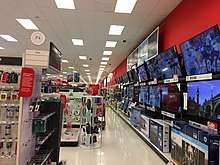
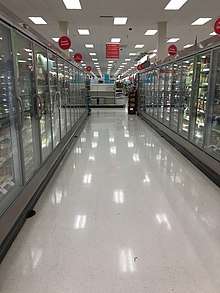
Target Brands is the company's brand management division that oversees the company's private label products. In addition, Bullseye Dog is a mascot, and the Bullseye Design and 'Target' are registered trademarks of Target Brands.
- Good & Gather, food and beverage brand replacing Archer Farms and Simply Balanced.[32]
- Archer Farms, up-market grocery products;
- Market Pantry, value grocery products;
- Simply Balanced, organic grocery products;
- Sutton & Dodge, a premium meat line;
- Boots & Barkley, a pet food and supply line;
- Embark, an outdoor gear line of camping and travel equipment;
- Room Essentials, a low-end home goods line.
- Threshold, a premium furniture line;
- Fieldcrest, bedding & bath line in partnership with brand owner Iconix Brand Group;
- up & up. Target issued a re-launch of the Target brand as up&up to include an expanded product selection and a new design. The up & up brand offers essential commodities including household, healthcare, beauty, baby, and personal care products. The brand claims to offer products of equal quality to national brands at a fraction of the cost, averaging a savings of 30 percent.[33] As of September 2009, up & up offers over 800 products across 40 categories.[34]
Other private labels include brands launched in July 2016, during Back to School sales.
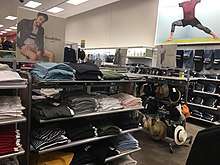
- Pillowfort, a children's line of bedding
- Cat and Jack, a children's line of apparel and accessories.
- Cloud Island, a baby's line of bedding and clothing.
- Project 62, a household goods line placed alongside Room Essentials.
- Goodfellow & Co., a clothing and personal-care line for men, with the name being an homage to their beginnings as Goodfellow Dry Goods
- A New Day, a clothing line for women.
- JoyLab, a fitness clothing line.
- Hearth and Hand, a home & lifestyle brand, in collaboration with Magnolia
After the launch, the clothing and bedding brands made a big hit and was successful. Target executives claim that the new brands increased sales by $1 billion and increased 15% in revenue, only during their first year.[35]
8 Target private label brands that launched in 2018[36]
- Universal Thread, a denim lifestyle brand
- Opalhouse, eclectic home decor
- Heyday, a line electronic accessories
- Original Use, male clothing brand targeting Gen-Z and Millennials.
- Wild Fable, women's clothing brand targeting Gen-Z.
- Made By Design, a homelines brand, made up of home basics like towels, cooking utensils, glassware, plates, pots, kitchen gadgets, and more.
- Prologue, sophisticated female line of clothing.
- Smartly, essential commodity brand including household, healthcare, beauty, and personal care products.
In addition, Target recently released 3 new intimates, loungewear, and sleepwear brands for women on February 25, 2019:[37]
- Auden, an intimates and lingerie exclusive brand
- Stars Above, their in-house brand for sleepwear
- Colsie, an intimates and loungewear brand
On January 9, 2020, Target announced its new activewear brand, All In Motion.[38]
Former brands include:
- Cherokee, children's and women's clothing. On September 10, 2015, it was announced that Target stores would cease carrying the brand when its partnership with Cherokee Inc. expired on January 31, 2017. It was replaced by Cat & Jack;
- Circo, toddler's and kids clothing. The brand was replaced by Cat & Jack upon debut.
- Merona, a clothing brand purchased by Target in 1991;
- Mossimo Supply Co., a clothing line. In partnership with the brand owner Iconix Brand Group;
- Xhilaration and Gilligan & O'Malley product lines of intimates and sleepwear were discontinued after the release of the brands Auden, Stars Above, and Colsie.
Website
Screenshot 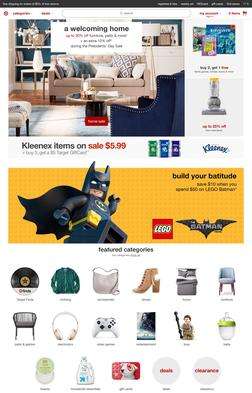 | |
Type of site | E-commerce |
|---|---|
| URL | target.com |
| Alexa rank | |
| Commercial | Yes |
| Registration | Optional but required for some features |
| Launched | 2000, August 2011 (rebrand) |
| Current status | Online |
Target.com owns and oversees the company's e-commerce initiatives, such as the Target.com domain. Founded in early 2000 as target.direct, it was formed by separating the company's existing e-commerce operations from its retailing division and combining it with its Rivertown Trading direct marketing unit into a stand-alone subsidiary.[40] In 2002, target.direct and Amazon.com's subsidiary Amazon Enterprise Solutions created a partnership in which Amazon.com would provide order fulfillment and guest services for Target.com in exchange for fixed and variable fees. After the company sold Marshall Field's and Mervyn's in 2004, target.direct became Target.com. The domain target.com attracted at least 288 million visitors annually by 2008, according to a Compete.com survey.[41] In August 2009, Target announced that they would build and manage a new Target.com platform, independent of Amazon.com. This new platform was to launch in 2011, in advance of the holiday season. Prior to the announcement, Target and Amazon had extended their partnership until 2011.[42] In January 2010, Target announced their vendor partners for the re-platforming project. These partners include Sapient, IBM, Oracle, Endeca, Autonomy, Sterling Commerce and Huge, among others.[43] The re-platformed Target.com officially launched on August 23, 2011, effectively ending the partnership with Amazon.com.[44]
Former subsidiaries
- Target Portrait Studio was a chain of portrait studios that were located in select Target stores. The chain, which was operated by Lifetouch, opened in 1996 and ceased operations on January 28, 2017.[45]
- Target Canada were the chain of Target stores in Canada. It was formed in 2013 when Target acquired Zellers and converted into Target stores. Target Canada was in operation for two years until the closure of all stores in 2015.[46]
Supply chain
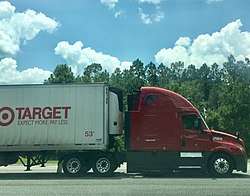
As of May 2016, Target Corporation operates 39 distribution centers across the United States.[47] With the exception of vendor supplied items, such as greeting cards and soda, these distribution centers ship items directly to Target stores. Also, unlike Walmart, Target's grocery selection does not come from their own distribution centers, but from the companies with whom Target has partnered.[48]
The retail chain's first distribution center opened in Fridley, Minnesota, in 1969. It included a computerized distribution system and was known as the Northern Distribution Center. During this time, the chain consisted of seventeen stores after having expanded into Oklahoma and Texas.[49]
On August 9, 2004, Target announced to their suppliers that they were going to perform a trial on the effects of radio-frequency identification on the efficiency of supply chain management in the Dallas–Fort Worth metroplex. This trial involved one Target distribution center and ten nearby Target stores. Here, RFID tags were placed on the bar codes of pallets and cartons to track the goods from the suppliers to the distribution center, and from the distribution center to the stores.[50] As of 2009, RFID had been phased out of the Dallas–Fort Worth stores.
Target opened three new distribution centers in 2006 (Rialto, California, DeKalb, Illinois) and one in 2009 (Newton, North Carolina) to support the growth of its stores. On January 27, 2009, Target announced the closing of its distribution center in Maumelle, Arkansas, the second-oldest in the company. The reason cited was the need to ensure that Target remains competitive in the long-term.[51] In June 2009 Target opened a new distribution center to supply more than 60 stores in three states.[52]
SuperTarget and PFresh stores require fresh produce, refrigerated and frozen items. Food distribution centers owned by SuperValu have been utilized by Target for many years. In October 2003, SuperValu's facility in Phoenix, Arizona, was converted to serve Target exclusively.[53] The same change was implemented at the SuperValu center in Fort Worth, Texas.[54] A new distribution center was constructed by Target in Lake City, Florida, to serve the Southeast, but it was operated by SuperValu until 2011 when it transitioned to Target.[53] A fourth center in Cedar Falls, Iowa, opened in 2009 and is unique in that it is located adjacent to a standard Target Distribution Center, each utilizing the same dispatch office.[54] Other warehouses owned by SuperValu are still used in other regions, but Target plans to replace those over the next few years.[53] In Colorado, stores are serviced through FreshPack Produce Inc. of Denver.[48] In the mid-Atlantic region/Philadelphia market, C&S Wholesale Grocers services the fresh produce, meat, dairy, bakery, & frozen needs to "PFresh" stores. Target partnered with Swisslog Holding to use a semi-automated monorail picking system called the CaddyPick system for use in the food distribution centers.
The company operates four facilities to receive shipments from overseas manufacturers and suppliers. They are located near ports at Rialto, California; Savannah, Georgia; Lacey, Washington; and Suffolk, Virginia. Merchandise received is sent directly to Regional Distribution Centers. Internet sales orders from the Target Direct division, which operates from the Target.com website, are processed by the facility in Woodbury, Minnesota, with some support from Savannah, Georgia, and other vendors. New centers opened in Ontario, California, and Tucson, Arizona, in 2009.[54]
Distribution centers
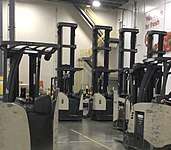 Reach forklifts at a Target distribution center.
Reach forklifts at a Target distribution center.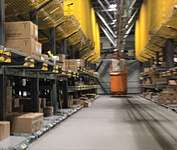 Target distribution center with a Swisslog CaddyPick system.
Target distribution center with a Swisslog CaddyPick system.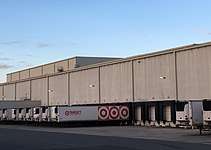 T-3892 Target food distribution center in Lake City, Florida.
T-3892 Target food distribution center in Lake City, Florida.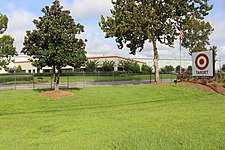 T-0556 Target regional distribution center in Tifton, Georgia.
T-0556 Target regional distribution center in Tifton, Georgia.
| Distribution Center | Type | Location |
|---|---|---|
| T-580 | Regional | Madison, Alabama |
| T-588 | Regional | Phoenix, Arizona |
| T-9478 | E-Commerce Fulfillment | Tucson, Arizona |
| T-0553 | Regional | Fontana, California |
| T-9479 | E-Commerce Fulfillment | Ontario, California |
| T-3806 | Regional | Rialto, California |
| T-3807 | Import | Rialto, California |
| T-3899 | Food | Rialto, California |
| T-0593 | Regional | Shafter, California |
| T-0555 | Regional | Woodland, California |
| T-0554 | Regional | Pueblo, Colorado |
| T-3892 | Food | Lake City, Florida |
| T-3808 | Regional | Midway, Georgia |
| T-3810 | Import | Savannah, Georgia |
| T-0556 | Regional | Tifton, Georgia |
| T-3809 | Regional | DeKalb, Illinois |
| - | Central Returns | Indianapolis, Indiana |
| T-0559 | Regional | Indianapolis, Indiana |
| T-0590 | Regional | Cedar Falls, Iowa |
| T-3895 | Food | Cedar Falls, Iowa |
| T-3803 | Regional | Topeka, Kansas |
| T-0587 | Regional | Galesburg, Michigan |
| T-0551 | Regional | Fridley, Minnesota |
| T-9407 | E-Commerce Fulfillment | Woodbury, Minnesota |
| T-3844 | E-Commerce Fulfillment | Perth Amboy, New Jersey |
| T-3802 | Regional | Amsterdam, New York |
| T-0579 | Regional | Wilton, New York |
| T-3811 | Regional | Newton, North Carolina |
| T-3880 | Food | West Jefferson, Ohio |
| T-3804 | Regional | West Jefferson, Ohio |
| T-0558 | Regional | Albany, Oregon |
| T-0589 | Regional | Chambersburg, Pennsylvania |
| - | E-Commerce Fulfillment | York, Pennsylvania |
| T-0594 | Regional | Lugoff, South Carolina |
| T-3897 | Food | Denton, Texas |
| T-3801 | Regional | Midlothian, Texas |
| T-3801 | Regional | Tyler, Texas |
| T-0560 | Regional | Stuarts Draft, Virginia |
| T-3800 | Import | Suffolk, Virginia |
| T-0600 | Import | Lacey, Washington |
| T-0557 | Regional | Oconomowoc, Wisconsin |
Corporate affairs
Headquarters
Target Corporation has its headquarters on Nicollet Mall in Minneapolis,[57] near the site of the original Goodfellows store. The complex includes Target Plaza North and Target Plaza South. Ryan Companies developed the complex, and Ellerbe Becket served as the architect. Target had the approximately $260 million complex developed to provide one location of office space for 6,000 employees. The 14-story Target Plaza North has 600,000 square feet (56,000 m2) of office and retail space while the 32-story Target Plaza South has 1,250,000 square feet (116,000 m2) of space.[58]
Brian Cornell is the CEO of Target Corporation. In January 2016, Cornell began making home visits in an effort to understand better the needs and desires of his customers.[59] In January 2016, Target fired Tina Tyler from her job as chief stores officer. She was replaced with long-time employee Janna Potts.[60]
Diversity
The company states that "individuality may include a wide spectrum of attributes such as personal style, age, race, gender, ethnicity, sexual orientation, language, physical ability, religion, family, citizenship status, socio-economic circumstances, education, and life experiences."[61]
The Target employee diversity initiative is called "All Together Target".[62] It specifically seeks to work with vendors and contractors that are owned by minorities or women.[63]
In February 2012, the company extended the team member discount to same-sex partners of employees. It had received a 100 on the Human Rights Campaign Corporate Equality Index Score, prior to donating funds to Minnesota Forward.[64]
The National Association for the Advancement of Colored People has repeatedly given Target failing grades on its annual Economic Reciprocity Initiative report card, a measure of the company's "commitment to the African-American citizenry". In 2003 and 2005, the NAACP has rated Target an "F" on this report; in 2004, Target was rated a "D-".[65][66][67] In 2006, when Target was asked why it didn't participate in the survey again,[68] a representative explained, "Target views diversity as being inclusive of all people from all different backgrounds, not just one group."[69]
In February 2006, the National Federation of the Blind (NFB) filed a class action discrimination lawsuit in Northern California's Alameda County Superior Court, claiming that Target's commercial website contains "thousands of access barriers that make it difficult, if not impossible, for blind customers to use."[70] Target Corporation settled the lawsuit in October 2008, paying $6 million and agreeing to work with the NFB over the next three years improving the usability of the Target.com site.[71] August 24, 2009, the United States Equal Employment Opportunity Commission (EEOC) filed a discrimination lawsuit against Target Corporation for unlawfully denying reasonable accommodation to an employee with multiple disability-based impairments and substantially reducing his work hours due to the medical conditions.[72] According to the claims in the EEOC press release, Target's actions violated Title I of the Americans With Disabilities Act (ADA) and Title I of the Civil Rights Act of 1991.[73]
Philanthropy
Target is consistently ranked as one of the most philanthropic companies in the US. It ranked No. 22 in Fortune magazine's "World's Most Admired Companies" for 2010, largely in part to the donation efforts of the company as a whole.[74] According to a November 2005 Forbes article, it ranked as the highest cash-giving company in America in percentage of income given (2.1%).[75] Target donates around 5 percent of its pre-tax operating profit; it gives over $3 million a week (up from $2 million in years prior) to the communities in which it operates. It also gives a percentage of charges from its Target Visa to schools designated by the cardholders. To date, Target has given over $150 million to schools across the United States through this program.
Further evidence of Target's philanthropy can be found in the Target House complex in Memphis, Tennessee, a long-term housing solution for families of patients at the city's St. Jude Children's Research Hospital. The corporation led the way with more than $27 million in donations, which made available 96 fully furnished apartments for families needing to stay at St. Jude over 90 days.
Target has a no-solicitation rule at its properties, as it seeks to provide a "distraction-free shopping experience for its guests." Exemptions to this policy were previously made for the Salvation Army red kettles and bell-ringers outside Target stores during the holidays through Christmas. In 2004, however, Target asked the organization to explore alternate methods to partner with Target. Target donates to local Salvation Army chapters through its grant program and annually to the United Way of America (the Salvation Army is a member of the United Way coalition).
In 2005, Target and the Salvation Army[76] created a joint effort called "The Target/Salvation Army Wish List", where online shoppers could donate goods to the organization for hurricane victims by buying them directly from Target.com between November 25, 2005, and January 25, 2006. In 2006, they created another joint effort called "The Target/Salvation Army Angel Giving Tree",[77] which is an online version of the Salvation Army's Angel Tree program;[78] in addition to donating proceeds made from the sales of limited edition Harvey Lewis angel ornaments within Target's stores. During the Thanksgiving holiday of 2006, Target and the Salvation Army partnered with magician David Blaine to send several families on a shopping spree the morning of Black Friday. The challenge held that if Blaine could successfully work his way out of a spinning gyroscope by the morning of Black Friday, then several families would receive $500 shopping certificates. The challenge was completed successfully by Blaine.[79]
During disasters, Target has been a major benefactor for relief efforts. Target provided monetary and product donations during the September 11 attacks; it also donated money for relief efforts for the 2004 tsunami in South Asia and donated $1.5 million (US) to the American Red Cross in the aftermath of Hurricane Katrina in 2005. It also allowed its store properties in the affected area to be used as command centers for relief organizations and donated supplies such as water and bug spray.
Target will often donate its unused, returned or seasonal merchandise (particularly clothing) to Goodwill Industries.
Environmental record
In 2007, Target Corporation agreed to reduce its sales on all materials containing polyvinyl chloride (PVC).[80] Testers found toxic lead and phthalates and large amounts of PVC in toys, lunch boxes, baby bibs, jewelry, garden hoses, mini blinds, Christmas trees, and electronics.[80] Several studies have shown that chemicals in vinyl chloride can cause serious health problems for children and adults.[80] The University of Illinois Medical Center in Chicago states that people who use products containing PVC can become exposed with harmful toxic phthalates and lead, which eventually can become a big contributor with dioxins.[80] Lois Gibbs, executive director of the Center for Health, Environment, and Justice, stated, "Target is doing the right thing by moving away from PVC and switching to safer alternatives."[80] Other companies reducing the PVC on their shelves include Walmart, Microsoft, Johnson & Johnson, Nike, and Apple.[80] Target stores have been taking environmental measures by reusing materials within their stores and recycling products such as broken hangers, cardboard, and rechargeable batteries.[81] Target is beginning to reduce energy use with energy-efficient storefronts and reducing waste with recycling programs.[82] All Target stores in the United States use plastic carts with metal frames. In mid-2006, Target took it a step further when it began introducing a newer cart design made entirely of plastic. It also uses the same design in its hand-use baskets.[83]
Target released a 13-page report in 2007 that outlined their current and future plans for becoming more earth-friendly according to LEED. Such efforts include installing sand filtration systems for the stores' wastewater. Recycling programs will be aimed at garment hangers, corrugated cardboard, electronics, shopping carts, shrink wrap, construction wastes, carpeting, and ceiling tiles and roofing materials. All stores in Oklahoma will be partnered with Oklahoma Gas & Electric to exclusively use wind power for all Target stores in order to reduce greenhouse gas emissions. Stores nationwide use only LED and fluorescent lights and low-flow restrooms that reduce wastewater by 30%. Some Target stores are installing roof gardens or green roofs, which absorb stormwater and cut down on surface runoff, mitigate temperature fluctuations and provide habitats for birds. There are currently four green-roof Target stores in Chicago.
Target carries over 700 organic and alternative products from brands such as Archer Farms, Burt's Bees, and Method Products. They also sell clothes made from organic cotton, non-toxic cleaners, low-energy lighting and electronics, non-toxic and non-animal tested cosmetics, and furniture made from recycled materials. As of June 2007, Target has been offering reusable shopping bags as an alternative to disposable plastic bags. Target gift cards are made from corn-based resins. All of the stores' packaging is done with a modified paperboard/clamshell option and has goals for phasing out plastic wrap completely.[84]
In collaboration with MBH Architects, Target's first "green" building was a 100,000+ square foot Target store built-in 1995 in Fullerton, California. It was a part of the EPA Energy Star Showcase for its use of skylights that cut the original energy consumption by 24% with a 5-year payback.[85] Target and MBH Architects were awarded the "Green Lights Partner/Ally of the Year Award".[86]
Target is the only national retailer employing a Garment Hanger reuse program, which keeps millions of pounds of metal and plastic out of landfills. In 2007, this program prevented 434 million hangers from entering landfills.
On June 15, 2009, the California Attorney General and 20 California District Attorneys filed a lawsuit in Alameda County alleging that Target stores across the state have been illegally dumping hazardous wastes in landfills.[87]
On October 1, 2009, Target Corporation agreed to pay a $600,000 civil penalty for importing and selling a variety of toys with lead paint levels that were higher than is legally allowed. The Consumer Products Safety Commission alleged that "Target knowingly imported and sold the illegal Chinese-made toys between May 2006 and August 2007."[88] A similar problem occurred a few months later in February 2010, when Target pulled Valentine's Day "message bears" from its shelves at the request of the California attorney general's office. The bears, which were manufactured in China, contained more lead than is permissible under federal law for children under 12.[89]
A class action suit was filed in 2014 in the U.S. District Court for the Northern District of Ohio, on behalf of consumers in Ohio that purchased Target-brand wet wipes. The lawsuit filed against Target Corporation alleges the retailer misled consumers by marking the packaging on its up & up® brand wipes as flushable and safe for sewer and septic systems. The lawsuit also alleges that so-called flushable wipes are a public health hazard because they are alleged to clog pumps at municipal waste-treatment facilities.[90]
On Dec. 5, 2018, Alameda County District Attorney O’Malley announced fining Target $7.4 million for putting illegal e-waste, medical supplies and private information into the garbage.[91]
Customer privacy
In December 2013, a data breach of Target's systems affected up to 110 million customers.[92][93] Compromised customer information included names, phone numbers, email and mailing addresses.[94] In March 2015, Target reached a class-action settlement with affected consumers for $10 million (plus class-action attorney fees).[95] In May 2016, Target settled with affected banks and credit unions for $39 million (plus class-action attorney fees), of which $19 million would be disbursed by a MasterCard program.[96]
Labor relations
In 2015, Target followed Walmart in raising the minimum wage to $9 per hour.[97] Two years later, Target announced that the minimum hourly wage would be increased to $11 by October 2017 and pledged to raise it to $15 (referred to as "living wage" by labor advocates) by 2020.[98][99] By April 2019, the company announced that it was on track to meet this goal, increasing its minimum wage to $13 per hour.[100]
Corporate identity
Logo
.png) Target logo, 1962–1968
Target logo, 1962–1968.svg.png) Target logo, 1968–present
Target logo, 1968–present Target logo, used as primary logo from 1968–2004 and secondary logo from 2004–2018
Target logo, used as primary logo from 1968–2004 and secondary logo from 2004–2018 Target logo, 2004–2018
Target logo, 2004–2018.svg.png) Target logo, 2018–present
Target logo, 2018–present Target Greatland logo, 1990–2006
Target Greatland logo, 1990–2006 Original SuperTarget logo, 1995–2006
Original SuperTarget logo, 1995–2006- Second SuperTarget logo, 2006–2018
 CityTarget logo, 2012–2015
CityTarget logo, 2012–2015 TargetExpress logo, 2014–2015
TargetExpress logo, 2014–2015 Super Target logo, 2004–2018
Super Target logo, 2004–2018
Differentiation from competitors
Since its founding, it has intended to differentiate its stores from its competitors by offering what it believes is more upscale, trend-forward merchandise at lower costs, rather than the traditional concept of focusing on low-priced goods. Douglas J. Dayton, one of the Dayton brothers, explained John Geisse's concept:
"We will offer high-quality merchandise at low margins because we are cutting expenses. We would much rather do this than trumpet dramatic price cuts on cheap merchandise."[49]
As a result, Target stores tend to attract younger customers than Walmart, among other competitors. The median Target shopper is 40, the youngest of all major discount retailers that Target competes directly against. The median household income of Target's customer base is roughly $64,000. Roughly 76% of Target customers are female, and more than 43% have children at home. About 80% have attended college and 57% have completed college.[101][102]
In October 2008, Target announced plans to fight the perception that their products are more expensive than those of other discount retailers. It added perishables to their inventory, cut back on discretionary items, and spent three-quarters of their marketing budget on advertising that emphasizes value and includes actual prices of items featured in ads. Target also planned to slow its expansion from about 100 stores a year down to 70 stores a year.[103][104][105]
Target stores are designed to be more attractive than large big-box stores by having wider aisles drop ceilings, a more attractive presentation of merchandise, and generally cleaner fixtures. Special attention is given to the design of the store environment: graphics reinforce its advertising imagery, while shelves are dressed with contemporary signage, backdrops, and liners, often printed on inexpensive material such as paper, corrugated and foam boards. Some stores, particularly those in the vicinity of major airports, have a bullseye painted on the roof that can be seen from above: the stores in East Point, Georgia near Hartsfield-Jackson Atlanta International Airport; Rosemont, Illinois, near O'Hare International Airport; Potomac Yard, Virginia, near Ronald Reagan Washington National Airport; College Point, New York (Queens), east of LaGuardia Airport; and Richfield, Minnesota, adjacent to Minneapolis–St. Paul International Airport are among such locations.[106]
Target stores do not sell firearms. In the early 1990s, they ceased sales of toy guns that looked realistic and limited its toy gun selection to ones that were brightly colored and oddly shaped. In 2014, Target also "respectfully" asked their guests to leave any firearms at home when visiting the store.[107] They do not sell tobacco products and have not sold cigarettes since 1996.[108][109]
Most Target stores don't play music, but may be changing that from 2017 with a rebranding process, adding music to the rebranded stores.
Targét
Some people jokingly give Target the pseudo-French pronunciation /tɑːrˈʒeɪ/ tar-ZHAY, as though it were an upscale boutique. Though this practice is often attributed to Oprah Winfrey's usage on her television show, it is first attested in 1962, the year the first Target store opened. Target once sold a line of shoes called "Miss Targé";[110] this was reinforced by a 1980s television advertisement starring Didi Conn. This pronunciation has also led some people to incorrectly believe that the company is French-owned.[48] In recognition of the nickname's popularity and cachet, Target Corporation licensed its new name and logo to Brand Central LLC in 2006, complete with an accent over the letter "E" for a new line of clothing aimed at more upscale fashion customers. The line, "Targét Couture", was originally sold in Los Angeles-based store Intuition, which deals with high-end brands.[111][112]
Nomenclature
Target uses a practice that was derived in 1989 from The Walt Disney Company[48] by calling its customers "Guests", its employees "Team Members", and its supervisors "Team Leaders". Also, managers are known as "Executive Team Leaders (ETLs)," "Senior Team Leaders (SRTLs)," or "Guest Service Team Leaders (GSTLs)" and the Store Manager is known as the "Store Team Leader (STL)". Further up the "chain of command" are "District Team Leaders (DTL)", "Group Team Leaders (GTL) (sometimes also Group Vice President)", Regional Team Leaders (RTL) (sometimes also Regional Vice President), and finally corporate-level executives.
This practice began to be revised in 2018 and became more widespread in 2019 as the Group Team Leader became the Group Operations Director. District Team Leader became the District Senior Director. The Store Team Leader became Store Director. Executive Team Leaders were shortened to Executive Team Lead. Other Team Leaders retained their title though some of the department names changed such as Guest Service Team Leader was renamed Service & Engagement Team Leader. Front of store team members was renamed Guest Advocates. Specialty areas in Style, Beauty and Tech are considered Consultants. Other areas such as General Merchandise, Presentation, Inbound, Fulfillment, Food Service and Reverse Logistics are considered Experts.
Product lines and partnerships
Target has many exclusive deals with various designers and name brands, including Finnish design company Marimekko; architect Michael Graves; athletic wear company Converse; Portland-based undergarment designer Pair of Thieves; Italian fashion label Fiorucci; fashion designers Lilly Pulitzer, Liz Lange, Mossimo Giannulli, and Isaac Mizrahi, among others. To further increase their fashion profile, Target also created its fashion-forward Go International line, which hires famous designers to design collections available only for a few months.[113]
Target, after hiring architect Michael Graves to design the scaffolding used to renovate the Washington Monument and contributing US$6 million to the restoration plan, introduced its first designer line of products in 1999, the Michael Graves Collection of housewares and home decor products.[113] Walmart and Kmart have followed Target's lead by signing exclusive designers to their stores as well. Target also partners with well-established national brands to create exclusive collections for its stores.[113]
Target also signed an exclusive deal with Food Network to sell VHS tapes of TV shows featuring popular chefs such as Alton Brown, Paula Deen, and Rachael Ray.
In 2005, Target introduced a major revision of prescription bottles, which it calls the ClearRx system. The redesigned bottles are color-coded, flattened-out and turned upside down, providing more room for the label. This system was based on the patent[114] by student Deborah Adler and was named one of TIME's "Most Amazing Inventions of 2005".[115]
Sometimes manufacturers will create red-colored items exclusively for Target. In 2002, Nintendo produced a red special edition variant of the Game Boy Advance, which featured the Target logo above the screen.[116]
In 2005, IFC began a partnership with Target to promote a selection of independent films, both in Target stores and on IFC Monday nights at 9:00 pm Eastern. Originally titled IFC Cinema Red, the promotion was rebranded on-air as The Spotlight in 2007. The in-store headers refer to the selected titles as IFC Indies – Independent films chosen for Target by the Independent Film Channel.[117]
In 2016, Target began to enforce gender neutrality in its marketing of toys, and no longer explicitly listed specific toys as being for "boys" or "girls". This practice was expanded with the February 2016 launch of new children's decor line, Pillowfort, which will replace its Circo brand and feature more gender-neutral designs and color schemes.[118]
Gift cards
The Target GiftCard is the retailing division's stored-value card or gift card. Target sells more gift cards than any other retailer in the United States and is one of the top sellers, by dollars and units, in the world.[119] The unique designs of their cards contribute to their higher sales, as well as Target's policy of no expiration dates or service fees.[120] Past and current designs include lenticular, "scratch and sniff" (such as peppermint during the Christmas season), glow in the dark, LED light-up, a gift card on the side of a bubble blower, a gift card that can function as a CD-ROM, and even a gift card that allows the sender to record a voice message. A current environmentally friendly gift card is made from bioplastic manufactured from corn.[121] Target rolled out a new MP3 player gift card for the 2006 holiday season. It holds 12 songs and must be purchased with an initial value of at least $50.
Beginning in January 2010, Target Stores rolled out Mobile GiftCards, through which one can produce a GiftCard barcode on any web-capable cell phone. This data matrix barcode can be scanned at a Target POS like any physical card barcode, and balances can be stored, retrieved, and gifted with the convenience of a cell phone.[122]
Some of these unique design ideas are patented, and these patents are assigned to the Target Brands subsidiary. For example, some such Target GiftCard designs feature a wooden front side. On May 24, 2005, the United States Patent and Trademark Office granted U.S. patent D505,450 for the "ornamental design for credit or stored value card with wood layer" to inventors Amy L. Lauer and John D. Mayhew.[123] U.S. patent 7004398, for the "stored-value card assembly including a stored-value card, an edible product, and a wrapper", was granted to Michael R. Francis and Barry C. Brooks on February 28, 2006.[124] Both patents have been assigned by their inventors to Target Brands, Inc.
Target GiftCards are also collector's items. Some of the first gift cards issued are valued at over $300 (even though the card doesn't have any money on it). Every year, Target introduces new Holiday GiftCards. In 2007, Target's Holiday GiftCards featured a wind-up flashlight, a musical gift card, a gift card that lights up, and a scented gift card.
Target forensic services
In 2006, The Washington Post revealed that Target is operating two criminal forensics laboratories, one at its headquarters and the other in Las Vegas.[125] Originally, the lab was created with the role of investigating internal instances of theft, fraud, and other criminal actions that have occurred on its own properties. Eventually, the company began offering pro bono services to law enforcement agencies across the country. Target's Forensic Services has assisted agencies at all levels of government, including such federal agencies as the Bureau of Alcohol, Tobacco, Firearms and Explosives, the Federal Bureau of Investigation, and the United States Secret Service.[126][127]
Criticism and controversy
Animal welfare concerns
In 2011, Mercy for Animals, a non-profit organization dedicated to preventing cruelty to farmed animals and promoting compassionate food choices and policies, uncovered alleged animal abuse at a Target egg supplier, Sparboe Farms.[128]
The investigation received international media attention; it aired first on ABC's Good Morning America,[129] World News Tonight with Diane Sawyer,[130] and 20/20.[131] As a result of the investigation and the public outcry that followed, Target immediately discontinued its relationship with the company.[132][133][134] In January 2016, Target Corp. announced that it will discontinue the use of eggs from caged hens, and become entirely cage-free by 2025.[135]
Refusal to stock albums after digital release
Target initially refused to sell Frank Ocean's Channel Orange and Beyoncé's self-titled album, due to those records becoming available to digital retailers, like iTunes, before physical copies were made. Target representatives argued that doing so impacted how well those records would sell at Target stores, and stocking them could cause the corporation to lose money.[136][137]
LGBTQ
Lady Gaga was expected to give the store an exclusive expanded edition of her then upcoming album Born This Way, but ended the deal after discovering that the then CEO Gregg Steinhafel donated to a political action group that supported an anti-gay candidate.[138] Target apologized[139] and began its outward support of the LGBTQ community. In 2012 it began by stocking gay pride merchandise and donating half of the profits to GLSEN. In 2014 it began featuring LGBTQ individuals and couples in national advertising.[140] In 2015, Target debuted their #takepride campaign, and partnered with GLSEN to produce a mini-documentary celebrating their 25th anniversary.[141][142] Target sponsors many LGBTQ non-profits including Human Rights Campaign, GLSEN, GLAAD, Family Equality Council, NGLCC and the Williams Institute. For the last three years, Target has been the presenting sponsor of GLAAD's Spirit Day. In 2017, Target was the founding partner of New York City's Pride Youth. Target has been ranked by LGBTQ Consumers as a favorite brand in 2016 & 2017 by Community Marketing Inc's 10th & 11th Annual LGBT Community Survey. Target has a score of 100 on the Human Rights Campaign Corporate Equality Index[143] for their corporate policies and practices pertinent to lesbian, gay, bisexual, transgender and queer employees. In 2019, Target donated $100,000 to GLSEN.[144]
Store closures
On Wednesday, November 4, 2015, Target announced that it would be closing thirteen of its stores in the U.S.[145] In a statement, Target spokesperson Kristy Welker said, "The decision to close a Target store is not made lightly. We typically decide to close a store after careful consideration of the long-term financial performance of a particular location."[146] The community of New Ulm, Minnesota protested the closure of the store in town with a social media group entitled "Save New Ulm Target", which gained 10,000 members within a week of its creation.[147] Despite the efforts of many members of the community and even Mayor Robert Buessman of New Ulm, Target upheld its decision to close the New Ulm store.[148] The New Ulm store and the other twelve stores closed on January 30, 2016.[149]
"Bathroom policy" and boycott
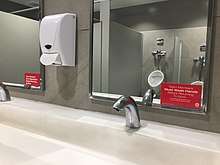
In April 2016, Target announced on its website that it would allow transgender customers and employees access to use restrooms and changing areas that correspond with the gender with which they identify, except where local laws require otherwise. The announcement read: "We believe that everyone—every team member, every guest, and every community—deserves to be protected from discrimination, and treated equally. Consistent with this belief, Target supports the federal Equality Act, which provides protections to LGBT individuals, and opposes action that enables discrimination. In our stores, we demonstrate our commitment to an inclusive experience in many ways. Most relevant for the conversations currently underway, we welcome transgender team members and guests to use the restroom or fitting room facility that corresponds with their gender identity."[150] The New York Times called this "the most prominent position taken by a national retailer".[151] In response, the American Family Association (AFA) launched a nationwide boycott; by April 28 about one million people had signed the AFA's petition.[152][153] Around the time of publicity about the policy, polls reported a drop from 42% to 38% of consumers noting they would shop at Target.[154] In mid-May, CEO Cornell said the boycott impacted "just a handful of stores across the country".[155] Some observers, such as Fortune's Phil Wahba, believed that Target's bathroom policy may have caused part of Target's drop in shopper traffic during the second quarter of 2016. On August 17, Target announced it would add a third, private, single-stall locking bathroom at many of its stores.[156] In 2017, Cornell claimed not to know about, or have approved, the policy before it was published. The policy cost the business US$20 million and caused sales to fall nearly 6% in the three quarters following.[157][156]
Absence of AEDs in stores
In 2014, the California Supreme Court ruled that Target stores do not have a positive duty to keep AEDs (Automated External Defibrillators) in stores for purposes of first aid. This decision came after a 49-year-old woman died following a heart attack in a Target store, and two family members filed a wrongful death lawsuit.[158][159]
Major sponsorships
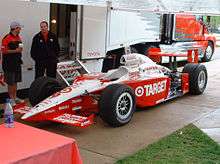
Events
- Target often supports major awards shows, such as the Emmys, Golden Globes, Grammys, and Oscars.[160]
- Target Corporation is a major sponsor of the annual Minneapolis Aquatennial, where it hosts the Target Fireworks Show, the largest annual fireworks show west of the Mississippi River and the fourth largest annual fireworks show in the United States.[161]
- Target was a sponsor of the 2006–2007 New Year's Times Square Ball Drop and had its logo placed on the confetti dropped during the celebrations as well as specially designed "2007" glasses.[162]
Sports
Minnesota United FC
.jpg)
In January 2017, Minnesota United FC, a Major League Soccer expansion team debuting for the 2017 Season, announced that Target would be the team's front-of-jersey match kit sponsor, as well as sponsoring MLS overall. This brings one of the largest sponsors in the league, especially for an expansion team making its debut appearance. The team also has an advantage of having a large, well-known hometown brand versus an entity outside the region, in addition to the financial benefits of such a large sponsor.[163]
Major League Soccer and US Youth Soccer
In 2017, Target announced a series of national, local and charitable initiatives that mark the retailer's largest-ever push into team sports. Target became an Official Partner of Major League Soccer in a multi-year deal that includes airtime during MLS broadcasts on Univision, FOX Sports and ESPN, opportunities for in-stadium experiences, player appearances and ownership of certain major MLS platform.[164] Target also announced a $14 million commitment to local youth soccer through two new national initiatives—an $8 million local soccer grant program, and a $6 million partnership with the U.S. Soccer Foundation to build 100 new soccer play spaces by 2020.[165] Target is the official sponsor of 2017[166]& 2018[167] MLS All Star Games.
Extreme Sports
Target sponsors pro freestyle motocross rider Nate Adams, pro snowboarder/skateboarder Shaun White, pro skateboarder Paul Rodriguez, pro BMX rider Mat Hoffman and pro surfer Kolohe Andino.[168][169][170]
Chip Ganassi Racing
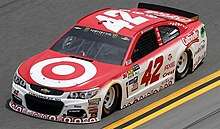
Target was a long-time sponsor of the IndyCar and NASCAR racing teams of Chip Ganassi Racing.[171] Target's relationship with Ganassi in IndyCar go back to 1990 when it began sponsoring Eddie Cheever. Some of their most famous drivers in the 1990s include Michael Andretti, Bryan Herta, and Arie Luyendyk. In the late 1990s, Target Chip Ganassi Racing had a four-year run of winning championships in CART, winning 1996 with Jimmy Vasser, 1997 and 1998 with Alex Zanardi, and 1999 with Juan Pablo Montoya.[172] Ganassi won their first Indianapolis 500 in 2000. The team moved full-time into the rival Indy Racing League in 2003,[173] and won in its first year of full-time competition, with Scott Dixon. Dixon won the championship again in 2008. The 2009 season marked the 20th anniversary of the Target race program. Franchitti won his second career IndyCar championship, and with Scott Dixon finishing second, gave Target a one-two sweep in the IndyCar Series. Dixon and Franchitti won 10 of 17 races (Dixon-5, Franchitti-5) and tied the team record from 1998 where Alex Zanardi and Jimmy Vasser combined to win 10 in the 19-race 1998 CART season. In 2010, Franchitti won the Indianapolis 500. He also won the series championship for the Target team, by five points over second-place finisher Will Power.[174]
Target started sponsoring stock cars in 2001 with Sterling Marlin when Chip Ganassi bought into the Felix Sabates stock car team. In the 2002 NASCAR Winston Cup Series season, the No. 41 Chip Ganassi Target car was driven by Jimmy Spencer, and from 2003 to 2005, Casey Mears drove the car. In 2006, Reed Sorenson took over the No. 41 when Mears moved to a different Chip Ganassi car on the same team. Sorenson drove the car through the 2008 season, and Target has also had some major sponsorship time on the Ganassi Racing No. 40 car with Dario Franchitti and Jeremy Mayfield who subbed for the injured Franchitti. The 40 team has since been shut down. For 2009, the Target sponsorship moved to the No. 42 driven by Juan Pablo Montoya with the newly formed Earnhardt Ganassi Racing.[175] Target also sponsored Earnhardt Ganassi Racing's No. 8 car driven by Aric Almirola, which it co-sponsors in some races with other sponsors such as Guitar Hero and TomTom until the team was disbanded in May 2009. Kyle Larson took over the No. 42 in 2014 and Target sponsored the No. 51 of Phoenix Racing for Larson's Sprint Cup Series debut.[176]

The Target Chip Ganassi[177] car driven by Dario Franchitti won the 94th running of the Indianapolis 500 on Sunday, May 30, 2010.[178]
Target ended its association with IndyCar racing at the end of the 2016 season.[179] In July 2017 Target announced that it would end its sponsorship of Ganassi's NASCAR team at the end of the year.[171]
Naming rights
Target owns the naming rights to the Target Center since it first opened in 1990.[180] Target also owns the naming rights to Target Field, a ballpark, in Minneapolis.[181]
Radio
Target was the founding sponsor of the Weekend America radio program.
In popular culture
- One of the earliest references to Target in popular culture is the film Career Opportunities (1991), written by John Hughes, in which an employee and a customer fall in love after hours inside a Target store.[182]
- American television program Saturday Night Live featured a recurring sketch in the 2000s starring the Target Lady, an overly enthusiastic Target cashier, played by cast member Kristen Wiig.
- Target is the namesake of an episode of the third season of American TV comedy Superstore. In the episode, an employee at big-box retailer "Cloud 9" leaves for a job at Target, and is accused of poaching employees.[183]
See also
- Design For All (product line)
References
- https://corporate.target.com/about/locations
- "US SEC: Form 10-K Target Corporation". U.S. Securities and Exchange Commission. Retrieved November 13, 2019.
- http://services.corporate-ir.net/SEC/Document.Service?id=P3VybD1hSFIwY0RvdkwyRndhUzUwWlc1cmQybDZZWEprTG1OdmJTOWtiM2R1Ykc5aFpDNXdhSEEvWVdOMGFXOXVQVkJFUmlacGNHRm5aVDB4TWpjM05qUXpPQ1p6ZFdKemFXUTlOVGM9JnR5cGU9MiZmbj1UYXJnZXRDb3Jwb3JhdGlvbl8xMEtfMjAxOTAzMTMucGRm
- "STORES Top Retailers 2017 - STORES: NRF's Magazine". STORES: NRF's Magazine. Retrieved December 1, 2018.
- Tuttle, Brad. "Why Target Is Focusing on Millennials and Cities Instead of Suburban Moms". MONEY. Retrieved October 12, 2016.
- "Fortune 500 Companies 2018: Who Made the List". Fortune. Retrieved November 10, 2018.
- Leinward, Paul; Mainardi, Cesare (December 15, 2010). "Why Can't Kmart Be Successful While Target and Walmart Thrive?". Harvard Business Review. Harvard Business Publishing. Retrieved March 17, 2016.
- "Target Financial Statements 2005-2019 - TGT". www.macrotrends.net.
- "Target Through the Years". Target Corporation. Retrieved March 10, 2016.
- "Target Launches Smaller CityTarget Stores To Appeal To Urban Shoppers". The Huffington Post. AOL. July 18, 2012. Retrieved October 6, 2015.
- "Target's 2016 store plan: urban, urban and more urban". Minneapolis/St. Paul Business Journal. American City Business Journals. December 23, 2015. Retrieved March 10, 2016.
- "New Store, Big City: Target to Open in Queens, N.Y., in 2016". Target Corporation. August 26, 2015. Retrieved March 10, 2016.
- "Target, Starbucks agree to add coffee shops to new Target stores". Louisville Business First. American City Business Journals. October 11, 2002. Retrieved March 10, 2016.
- "Target to add the 'PFresh' (now referred to as 'Market') grocery concept at 350 stores". Minneapolis/St. Paul Business Journal. American City Business Journals. November 18, 2006. Retrieved March 10, 2016.
- Morran, Chris (August 13, 2010). "Target Closing All Remaining Garden Centers". Consumerist. Retrieved March 10, 2016.
- "CVS Health and Target Announce Completed Acquisition of Target's Pharmacy and Clinic Businesses". December 16, 2015.
- Taylor, Kate (February 3, 2016). "Target opening CVS pharmacies in stores is scary news for consumers". Business Insider.
- Moore, Paula (January 7, 2011). "Target to roll out 'PFresh' concept store at Belmar center in Lakewood". Denver Business Journal. American City Business Journals. Retrieved March 10, 2016.
- Zimmerman, Ann (May 12, 2009). "Target Believes a Rebound Recipe Is in Grocery Aisle". Wall Street Journal. News Corp. Retrieved March 10, 2006.
- "E-Trade closes trading stations". San Francisco Business Times. American City Business Journals. June 6, 2003. Retrieved March 10, 2016.
- "Target Corporation Company Statistics". Statistic Brain Research Institute. September 3, 2015. Retrieved March 10, 2016.
- Harris, Elizabeth (January 16, 2014). "Target Tests Small Store for Urban Shoppers as Young People Pick Cities Over Suburbs". The New York Times. The New York Times Company. Retrieved March 10, 2016.
- "Keeping Things Simple: Rebranding our CityTarget and TargetExpress Stores". August 4, 2015. Retrieved June 2, 2019.
- Halter, Nick (August 4, 2015). "Target's dropping its TargetExpress and CityTarget names for small stores". Minneapolis / St. Paul Business Journal. Retrieved August 26, 2015.
- "Dinkytown mini-Target store will open in July" Archived September 12, 2014, at the Wayback Machine. Chusman & Wakefield Retail Services. July 7, 2014.
- Trinh, Jean (October 17, 2015). "Target Stores Planned For Koreatown And Near USC". LAist. Archived from the original on October 29, 2015. Retrieved November 5, 2015.
- "Keeping Things Simple: Rebranding our CityTarget and TargetExpress Stores". A Bullseye View. Target Corporation. August 4, 2015. Retrieved October 6, 2015.
- "List of Significant Subsidiaries". SEC.gov. SEC. Retrieved February 28, 2019.
- "Target's REDcard: What You Need to Know (TGT)". investopedia.com.
- "Vendor Compliance". Target Corporation. Archived from the original on November 5, 2013.
- "Associated Merchandising Corporation". The American Chamber of Commerce in Thailand.
- "Target launching private label in fight for grocery share". finance.yahoo.com. Retrieved August 19, 2019.
- "Target up & up Brand Offers Great Quality at Low Prices". Retrieved November 30, 2010.
- "up & up". Retrieved November 30, 2010.
- "Target aims for stars with new kids apparel brand Cat & Jack". Star Tribune. Retrieved November 4, 2016.
- "8 Target private label brands that launched this year". Retail Dive. Retrieved April 24, 2019.
- "Finding the Perfect Bra—and More—Is Now Easier and More Affordable at Target". Target Corporate.
- "New Year, New Us: Target's Newest Brand Celebrates the Joy of Movement for ALL Families". Target Corporate.
- "Target.com Site Info". Alexa Internet. Retrieved October 9, 2019.
- "Target is the name". Discount Store News. February 21, 2000. Archived from the original on March 12, 2007.
- "Site Profile for target.com (rank #28) | Compete". Siteanalytics.compete.com. Retrieved February 21, 2010.
- "Target to Build and Manage New Target.com Platform / Target Corp". Target. August 7, 2009. Retrieved November 25, 2011.
- "Target.com Announces Vendor Partners for Re-platforming Effort / Target Corp". Target. January 11, 2010. Retrieved November 25, 2011.
- "Target Launches Redesigned E-Commerce Website / Target Corp". Target. August 23, 2011. Retrieved November 25, 2011.
- Gajanan, Mahita (January 11, 2017). "Target will close its remaining portrait studios". Fortune. Retrieved May 5, 2018.
- Castaldo, Joe. "The Last Days of Target". Canadian Business. Retrieved February 28, 2019.
- "Target Corporate Fact Sheet". corporate.target.com. Retrieved May 31, 2016.
- Rowley, Laura (2003). On Target: How the World's Hottest Retailer Hit a Bull's-eye. Hoboken, New Jersey: John Wiley & Sons. ISBN 0-471-25067-8.
- From Roseville to Greatland, Target still hits the mark, Discount Store News, September 17, 1990.
- "Target Meets With Suppliers About RFID Plans". InformationWeek. August 10, 2004.
- "Target announces workforce reduction". January 29, 2009.
- "Target distribution center opens in Newton". WBTV. August 11, 2009.
- "Target aims for FL food distribution center". Refrigerated Transporter. February 1, 2007.
- "Target Stores, Target Distribution Centers". Target.
- Target Lights create evolving Minneapolis landmark, Minneapolis/St. Paul Business Journal, April 11, 2003.
- "Target Mpls skyline light show to go high def". Minneapolis / St. Paul Business Journal. May 13, 2011. Retrieved June 15, 2015.
- "Corporate Headquarters Archived November 18, 2010, at the Wayback Machine." Target Corporation. Retrieved on July 8, 2010. "Target Corporate Headquarters 1000 Nicollet Mall Minneapolis, MN 55440"
- "Target Office Towers." City of Minneapolis. Retrieved on July 8, 2010.
- Crosby, jACKIE (January 20, 2016). "Target CEO Brian Cornell visiting homes of customers". Star Tribune. Retrieved January 21, 2016.
- Ziobro, Paul (January 19, 2016). "Home Depot Replaces Head of U.S. Stores Business". Wall Street Journal. Retrieved January 21, 2016.
- Diversity Statement Archived June 29, 2006, at the Wayback Machine, Target Corporation.
- Target Diversity website Archived May 29, 2007, at the Wayback Machine, Target Corporation.
- "Supplier Diversity: Minority and Women Business Development Program". Target Corporation.
- "Profile: Target Corp". Human Rights Campaign.
- "NAACP General Merchandising Industry Report Card" (PDF). National Association for the Advancement of Colored People. Archived from the original (PDF) on February 13, 2006.
- "NAACP 2005 Industry Surveys Give Five Major Industries "C" and "D" Grades". National Association for the Advancement of Colored People. Archived from the original on May 24, 2011.
- "NAACP General Merchandising Industry Report Card" (PDF). National Association for the Advancement of Colored People. Archived from the original (PDF) on February 13, 2006.
- "2006 General Merchandising Industry Report Card". National Association for the Advancement of Colored People. Archived from the original on November 30, 2006.
- Erin Texeira (July 18, 2006). "NAACP Issues Corporate Report Cards". The Washington Post. Associated Press.
- Meyers, Michelle. "Blind patrons sue Target for site inaccessibility – CNET News". CNET. Retrieved February 21, 2010.
- Alexander, Steve (August 27, 2008). "Target settles suit over Web access". Star Tribune. Archived from the original on October 15, 2012. Retrieved February 21, 2010.
- "EEOC Sues Target For Disability Discrimination". ABC. August 25, 2009. Retrieved January 1, 2013.
- "Target Stores Sued For Disability Discrimination". Equal Opportunity Employment Commission. Retrieved February 21, 2010.
- "World's Most Admired Companies". CNN. Retrieved December 5, 2010.
- The Most Charitable Companies, Forbes, November 14, 2005.
- Target and The Salvation Army Announce Partnership Archived February 22, 2006, at the Wayback Machine, The Salvation Army, November 14, 2005.
- Target Launches Multi-Faceted Christmas Partnership With The Salvation Army Archived November 22, 2006, at the Wayback Machine, The Salvation Army, November 14, 2006.
- Salvation Army Giving Tree Archived November 28, 2005, at the Wayback Machine, Target.com.
- Magician David Blaine Ends Latest Stunt by Escaping From Gyroscope in NYC, FOXNews.com, November 24, 2006.
- "Target Stores to Phase Out Vinyl Plastic Products". Environment News Service. November 12, 2007. Retrieved May 4, 2008.
- Target Corporation 2006 Awards. Retrieved May 4, 2008 Archived April 18, 2008, at the Wayback Machine
- "Green Commerce Is Good Commerce". Retrieved June 15, 2015.
- "Target All Plastic Shopping Cart - Past Winners - International Plastics Design Competition". January 7, 2010. Archived from the original on September 7, 2012.
- Target Corporation. "Environmental Responsibility." Target Corporation Responsibility Report Archived May 29, 2008, at the Wayback Machine. June 2007. Date Accessed: April 16, 2008
- Dobrovolny, Peter. "Sustainability: High Performance Buildings Deliver Increased Retail Sales." Seattle.gov. Date accessed: March 17, 2008
- Brookter, Carolyn. "Target receives National Energy-efficiency award; EPA Partnerships Signify Commitment to Environment and Communities Archived May 8, 2008, at the Wayback Machine." Business Wire. June 4, 1996. Date accessed: April 16, 2008.
- "Attorney general targets Target". Press-Banner. Scotts Valley, Calif. June 26, 2009. Retrieved February 21, 2010.
- Target penalized for toys with lead paint, AZ Central. August 1, 2009. Retrieved June 27, 2013.
- "Target Bears Recall (Photo) "Message Bears" for Valentine's Day Pulled". National Ledger. February 10, 2010. Archived from the original on March 2, 2010. Retrieved February 10, 2010.
- Lorenzo B. Cellini; Tycko & Zavareei LLP (April 18, 2014). "Class Action Lawsuit Alleges That Target-Brand Flushable Wipes Are Not Suitable For Flushing And Can Clog Pipes And Damage Sewer And Septic Systems". The National Law Review. Retrieved April 19, 2014.
- "$7.4M Settlement with Target for Environmental Violations". Alameda County District Attorney's Office. Retrieved December 14, 2018.
- "Target says data breach up to 110 mn customers Archived January 12, 2014, at the Wayback Machine." AFP. Retrieved on December 27, 2013.
- "Target confirms encrypted PIN data stolen." USA Today. Retrieved on May 23, 2015.
- "Target: Breach affected millions more customers" Yahoo! Finance. Retrieved on May 22, 2015.
- Charles Riley and Jose Pagliery (March 19, 2015). "Target will pay hack victims $10 million". CNNMoney.
- "Target Data Breach Settlement With Banks Gets Final OK". Bloomberg BNA/Bloomberg Law. Retrieved May 21, 2016.
- "Target's $9 An Hour And A Minimum Wage Deal We Can All Get Behind". Forbes. March 20, 2015. Retrieved September 26, 2017.
- "Target raises its minimum wage and promises to get to $15 per hour by the end of 2020". Business Insider. September 25, 2017. Retrieved September 26, 2017.
- "Fight for $15 protesters across US demand living wage in day of action". Guardian. April 14, 2016. Retrieved September 26, 2017.
- Reagan, Courtney (April 4, 2019). "Target raises its minimum wage to $13 an hour, with goal of reaching $15 by end of 2020". CNBC. Retrieved April 4, 2019.
- "Community of Grand Forks". University of North Dakota. Archived from the original on December 19, 2007. Retrieved June 11, 2007.
- "Corporate Fact Card" (PDF). Target Corporation. October 10, 2007. Archived from the original (PDF) on November 28, 2007.
- "Value For Money Is Back – Target Does Marketing Right". Marketing Doctor Blog. October 23, 2008. Archived from the original on January 12, 2009.
- "Target to emphasize value, add perishables". Market Watch. October 23, 2008.
- "Earnings Preview – Target Corporation (NYSE:TGT)". iStockAnalyst. November 15, 2008. Archived from the original on January 4, 2013.
- "Target on rooftop in Rosemont, IL". Google Maps. Retrieved April 24, 2017.
- "Cheers, grumbles for Target no guns request". USA Today.
- Corporate Responsibility Report (PDF) Archived July 16, 2006, at the Wayback Machine, Target Corporation, January 31, 2006.
- "corporate".
- davek70s (September 1, 2011). "Target 1970". YouTube. Retrieved November 29, 2016.
- Mui, Ylan Q. (June 20, 2006). "Where "Target" Will Always Be "Tar-Zhay"". The Washington Post.
- "Gabrielle Union Demonstrating New Targét Couture Line at Brand's Launch Day". celebutopia.net.
- Is Target making a Graves mistake? Archived March 12, 2007, at the Wayback Machine, Discount Store News, February 8, 1999.
- US patent application 20030214129: Medication packaging and labeling system, U.S. Patent & Trademark Office.
- Best Inventions 2005: Healthy Options, Time, November 21, 2005.
- Target Gets Exclusive New GBA Color!, Nintendo World Report, Billy Berghammer, November 25, 2002.
- Target welcomes indies Archived April 24, 2008, at the Wayback Machine, BNET, July 2006.
- "Target takes gender-neutral approach with new kids home brand". Star-Tribune. Retrieved February 8, 2006.
- Target Corporation’s Third Quarter Earnings Release conference call, Securities Information from the SEC EDGAR database, November 11, 2004.
- "About GiftCards: GiftCards". Target. Retrieved February 21, 2010.
- Target's Bioplastic Gift Card, treehugger, January 31, 2006.
- Nelson, Ryan. "The Target Affiliate Program". Niche Facts. Retrieved July 2, 2018.
- US design patent D505,450: Credit or stored value card with wood layer, U.S. Patent & Trademark Office.
- U.S. Patent 7,004,398: Stored-value card with edible product, U.S. Patent & Trademark Office.
- Office of the Arizona Attorney General (2006). Target Corporation Assets Protection (PDF). Archived from the original (PDF) on June 20, 2007. Retrieved August 8, 2006.
- "Retailer Target Branches Out Into Police Work". The Washington Post. January 29, 2006.
- "Target sets sights on hard-to-crack cases". CNN. February 9, 2006.
- "McDonald's Cruelty: The Rotten Truth About Egg McMuffins". Mercy For Animals. Retrieved September 5, 2012.
- "ABC News Investigation: What's In Your Breakfast". ABC News Good Morning America. Retrieved September 4, 2012.
- "McDonald's - Friday, November 18, 2011". ABC World News Tonight with Diane Sawyer. Retrieved September 4, 2012.
- Galli, Cindy. "McDonald's, Target Dump Egg Supplier After Investigation". ABC News 20/20. Retrieved September 4, 2012.
- Ford, Dana. "McDonald's, Target drop egg supplier after animal cruelty report". CNN. Retrieved September 5, 2012.
- Hughlett, Mike. "McDonald's, Target fire Minnesota egg company". Star Tribune. Retrieved September 4, 2012.
- "McDonald's Drops Large McMuffin Egg Supplier". ABC News. Retrieved September 4, 2012.
- "Target stores switching to cage-free eggs by 2025". Chicago Sun-Times. January 20, 2016. Retrieved January 21, 2016.
- Dockterman, Eliana. "Why Won't Target Stock Frank Ocean's New Album?" – via newsfeed.time.com.
- "Target Not Selling Beyonce's New Album".
- "Lady Gaga Ends Deal With Target Over Its Support of Anti-Gay Groups".
- Scheck, Tom. "Target apologizes for donation to MN Forward".
- "See Target's New Ad Featuring Same-Sex Parents and Their Son". Time.
- "#TakePride With Target".
- Hudnell, Kari (June 2, 2015). "GLSEN and Target Team Up for 25th Anniversary Documentary". GLSEN. Retrieved January 30, 2020.
- Campaign, Human Rights. "HRC's 2018 Corporate Equality Index - Human Rights Campaign". Human Rights Campaign.
- Chumley, Cheryl (June 3, 2019). "Target goes full speed LGBTQ with 'Love my dads' shirts for kiddies". The Washington Times. Retrieved January 30, 2020.
- Garcia, Ahiza. "Target announces 13 U.S. store closures".
- "Target is Closing Another 13 Stores Nationwide". Money.
- "Effort launched to save New Ulm Target closure".
- nmadsen@mankatofreepress.com, Nancy Madsen. "Shoppers, city officials try to save New Ulm Target".
- "Target closing 13 stores in January 2016".
- Andrews, Travis (May 13, 2016). "Target CEO responds to nationwide boycott of the store over transgender bathroom policy". Washington Post. Retrieved January 2, 2018.
- Abrams, Rachel (April 27, 2016). "Target Steps Out in Front of Bathroom Choice Debate". The New York Times. Retrieved May 3, 2016.
- "More than 700,000 pledge to boycott Target over transgender bathroom policy". USA TODAY. Retrieved May 3, 2016.
- Wahba, Phil (April 28, 2016). "Nearly 1 Million Sign Pledge to Boycott Target Over Bathroom Policy". Fortune. Retrieved May 2, 2016.
- "Target brand perception falls, but it's not 'catastrophic'". USA TODAY. Retrieved May 28, 2016.
- "Target Says Boycotts Over Bathroom Policy Not Hurting Sales". Fortune. May 18, 2016. Retrieved May 28, 2016.
- "Target's Transgender-Friendly Bathroom Policy Is Costing It $20 Million". Fortune. Retrieved August 29, 2016.
- Hayley Peterson (April 6, 2017). "The Target boycott cost more than anyone expected — and the CEO was blindsided". Yahoo! News. Business Insider.
- California Court Hears Target AED Case. EMS World (Associated Press), Paul Elias, May 7, 2014.
- California's top court says Target not required to carry in-store defibrillators, Reuters, Jennifer Chaussee, June 23, 2014.
- "How Target Hits The Sponsorship Bulls-Eye". Sponsorship. February 24, 2014. Retrieved February 28, 2019.
- "Target Fireworks Show". 2011 Minneapolis Aquatennial. July 23, 2011. Archived from the original on January 21, 2013.
- "A Very Confetti New Year's". TIME. January 2, 2007.
- Burdine, Wes (January 18, 2017). "Target to Sponsor Minnesota United FC Jerseys and Major League Soccer". Fifty Five One. Retrieved February 28, 2019.
- "Target Announces Major Push into Soccer in the U.S.; Becomes Official Partner of Major League Soccer".
- "Target's $14-Million Move Will Help More Kids Play Youth Soccer".
- "Get Ready to See Stars! Target's the Presenting Sponsor of This Year's MLS All-Star Game".
- "Host info". mlssoccer.com.
- "Target Signs Professional Skateboarder Paul Rodriguez". August 13, 2010. Retrieved February 25, 2019.
- "Target Signs Professional Surfer Kolohe Andino". January 20, 2010. Retrieved February 25, 2019.
- "10 Years (and Counting): Shaun White and Target Celebrate Their Anniversary". July 23, 2012. Retrieved February 25, 2019.
- McFadin, Daniel (July 28, 2017). "Target withdrawing sponsorship from Chip Ganassi Racing after this season". NBCSports.com. Retrieved November 4, 2017.
- Martin, Bruce (March 1, 2000). "CART's Vasser, Montoya to race in Indy 500". ESPN.com. Retrieved November 4, 2017.
- "When the chips are up". Motor Sport. March 2011. Retrieved November 4, 2017.
- "Power failure gives IndyCar title to Franchitti". Emirates 24/7. October 3, 2010. Retrieved November 4, 2017.
- Mejia, Diego (January 21, 2009). "Target to sponsor Montoya again". autosport.com. Retrieved November 4, 2017.
- Ryan, Nate (October 1, 2013). "Kyle Larson to make Sprint Cup debut at Charlotte". USA Today. Retrieved October 14, 2013.
- "Target Ganassi Racing Sponsors". Chip Ganassi Racing. Archived from the original on March 25, 2013.
- "Franchitti Savors Sweet Second Indianapolis 500 Victory". Indianapolis Motor Speedway. May 30, 2010. Retrieved June 27, 2013.
- Cavin, Curt (August 22, 2016). "Going Off Target". Autoweek: 42–44.
- "TARGET AND WOLVES EXTEND ARENA PARTNERSHIP". NBA. September 19, 2011. Retrieved February 28, 2019.
- Sitaramiah, Gita (September 14, 2008). "Twins new ballpark gets its name: Target Field". Twincities. Retrieved February 28, 2019.
- "AFI Catalog – Career Opportunities". American Film Institute. Archived from the original on September 13, 2019. Retrieved January 10, 2020.
- ""Superstore" Target (TV Episode 2018) - IMDb". IMDb. Retrieved January 10, 2020.
Bibliography
- Leebrick, Kristal (2013). Dayton's: A Twin Cities Institution.
- Rowley, Laura (2003). On Target: How the World's Hottest Retailer Hit a Bull's-Eye. Hoboken, New Jersey: John Wiley & Sons. ISBN 978-0-471-25067-8.
External links
| Wikimedia Commons has media related to Target Corporation. |
- Official website retailing website
- Target Corporation corporate website
- Target International Shopping Page
- Business data for Target Corporation:
- Growth of Target, 1962–2008
- Political contributions and lobbying from the National Institute on Money in State Politics
